
|
|

| |
The DS420 was on the market from 1968 until 1992. During these 25 years the car had only one really large face lift. But many small changes were incorporated over the years. This web page tries to show the changes that were most visible from a non-technical point of view.
Apart from being of interest to DS420 lovers, the pictures may warn you when you are looking for a replacement part, and should be aware of the existence of different versions. But in those cases the only real solution is to compare part numbers in the different parts catalogues.
A very interesting article appeared in The Driving Member, the magazine of the Daimler and Lanchester Owners' Club in September 1991. This article was written by Keith Cambage, who was the head of the limousine operations from the transfer to Coventry in 1979 until his retirement. Note that September 1991 is only a few month before before the end of the lifespan of the DS420, Mr. Cambage looks back on the changes that were made to the limousine in his years. See it here.
Many photos on this page come in pairs to show an old and a new situation. If you click on one of a pair, you see enlarged versions of both together.
|
The summer of 1972 brought a larger collection of modifications.
This started near the end of April on cars 1M2181 (RHD) and 1M20072 (LHD).
They served to cut cost, and to eliminate a serious design problem
with the rear side windows.
These last side windows originally were of a wind-down type. A chrome dividing pillar provided a straight vertical edge, and a rubber sealing strip at the bottom of the window prevented too much rain water to seep in. Such a sealing strip is never sufficient, and therefore car doors always have draining holes at the bottom. But the last side window is not part of a door, and draining holes could not be provided because they would have to pass through the hollow beam at the bottom. Inside the beam is a complicated system of small drainage pipes, but they easily get clogged, e.g. by a Waxoil treatment. Then the water is trapped inside, and usually is not very forgiving about this. The new design had to close the body. The window was made hinged on its front pillar, and a small latch (see separate photo) replaced the wind-down handle. Rumour goes that the Royal clientele of the DS420 regretted this change very much, since the new window made waving to the crowds much less "effective". |
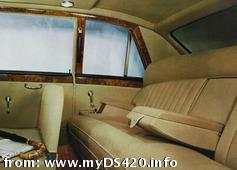
| |||
|
The disappearance of the wind-down handle called for a redesign of the rear arm rest; it became more stretched and the small horizontal wooden panel with the ashtray disappeared. The small ashtray in the old armrest had caused criticism as well, and it was replaced by a larger one in the side panel. Note that the two photos on the right are only meant to show the effects of the changed rear window opening, and the resulting difference in the design of the arm rest next to the bench and the ash tray above it. The fact that the lower photo has a different opening handle on the door is a different story, explained below. An intercom, introduced in 1975, and ventilation/blower openings, introduced much later, also found their way in this new side panel design, as can be seen on Greg Lewis' car in the "Cars and Owners" part of this web site. |
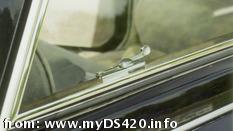
|
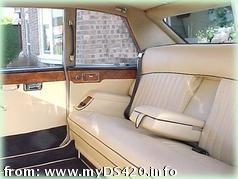
| ||
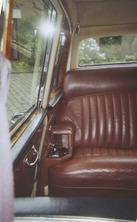 A major cost cutting was achieved by a substantial reduction of the
wood veneer parts: almost half the woodwork disappeared.
The surroundings of the side windows are the most visible ones,
but also the dividing glass was extended all the way to the roof of the car,
thus eliminating the large wooden panel above it.
Admittedly, the new design gave a much roomier impression
to the interior as a whole.
Even the six window sills lost their wooden inlay:
instead of half wood - half vinyl, they became vinyl covered only.
The two pictures to the left show the old style woodwork on
the window sills, the window surroundings, the top of the division window, etc.
A major cost cutting was achieved by a substantial reduction of the
wood veneer parts: almost half the woodwork disappeared.
The surroundings of the side windows are the most visible ones,
but also the dividing glass was extended all the way to the roof of the car,
thus eliminating the large wooden panel above it.
Admittedly, the new design gave a much roomier impression
to the interior as a whole.
Even the six window sills lost their wooden inlay:
instead of half wood - half vinyl, they became vinyl covered only.
The two pictures to the left show the old style woodwork on
the window sills, the window surroundings, the top of the division window, etc.

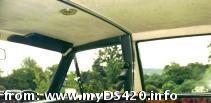
A press release, issued for the Earls Court exhibition in October 1972
gives an overview of the changes.
See it on the
Press Photos page of this site.
The DS420 went through a variety of changes for the gearbox (although always automatic), the gear selector handle, and the steering column and steering wheel. For a complete overview of how the situation in front of the driver looked like, we have a gallery of photos that are shown here in time sequence. Clicking on a photo will enlarge it, and will also show some additional information.
In July/August 1969, which is approx. after the first 200 cars, the steering wheel changed from a 17" diameter to a 16" version. I don't have a photo of the earliest model, My guess is that this change was triggered by complaints that the distance between bench and wheel was too narrow for many drivers.
Then, in late July 1969, a steering lock was added to the column, as is described in this Service Bulletin and shown on the publicity photos (click here). This addition was first applied for certain countries only, but not much later, with an improved design, on all cars.
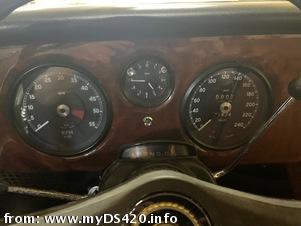
|
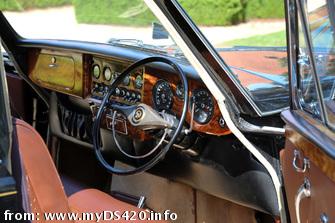
|
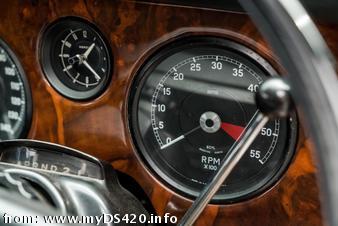
|
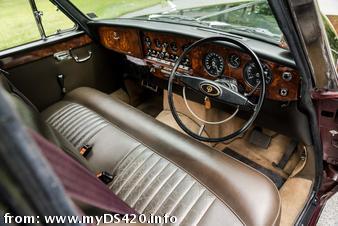
|
From the introduction in 1968 until the end of February 1974 a Borg Warner 8 automatic gearbox was used, with the selector stick on the steering column. The cowl on top of the steering column had a little display to show the currently selected position: P R N D2 D1 L. A small white metal arrow shifts along these positions; its linkage to the selector stick is purely mechanical and it is not always positioned exactly. But the selector handle has very noticeable "stops".
In February 1974 the BW8 was succeeded by the BW12, also with the selector on the steering column. The letters in the display changed to P R N D 2 1. Around the same time the steering wheel was modified again although the diameter stayed 16". The D-emblem in the centre changed from round to oval, and the shape surrounding the emblem was adapted with it.
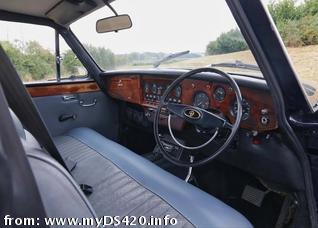
|
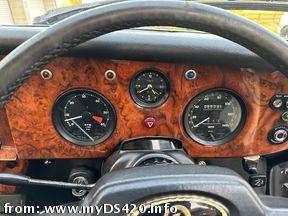
|
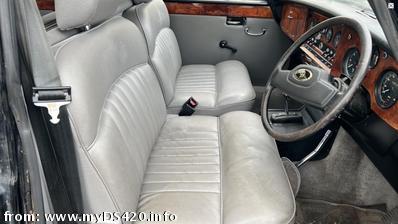
|
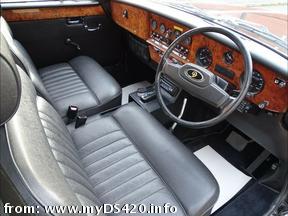
|
In July 1980 the General Motors 400 gearbox was introduced, with its selector handle in the floor. In October 1983 followed a change of the steering wheel: it went from a 16" diameter to 15¾". The surrounding of the oval 'Daimler' logo in the centre changed as well.
Initially, the single piece front bench
was maintained, but in 1984 the car got two individual front seats.
Those seats eliminated a major reason for complaints from the drivers,
who in general did not like the fixed bench that had no possibility at all
to adjust its position. As an extra support for this modification
the wall under the division window was repositioned slightly,
and its slope changed as well.
The little display for the gear positions on top of the steering column
lost part of its function,
although the direction indicator signal lamps were still there.
But the centre part of that display now got an entirely black inlay.
By the end of 1988 the entire steering column was changed. This was under pressure from its supplier, as Keith Cambage described in his very interesting 1991 article. The switch gear on the column was now housed in a smooth rectangular enclosing, and at the same time the dasboard in front of the driver got a revised panel to group various dip switches and signal lamps together.
|
A minor modification was done to the insignia on the air inlet grille (horn grille) under the headlamps. This started out as a round Daimler badge which, by the way, is the only place where the name Daimler is printed in full on the outside of the body of the earliest cars. These D-insignia have a tendency to fall off, so many cars drive around with empty base plates in the centre of the grilles. John Nash of the Daimler Enthusiasts Club in Christchurch, Dorset had these insignia remade, although in silver colour where the originals are gold colour. Somewhere between Summer 1973 and August 1974 the shape of the base plate was changed to a rectangular form for an insignia with the BL logo. A Parts technical bulletin from April 1976 finally announced the deletion of the badge from the grille. From then on the car is shown without any insignia at all. This may reflect the fact that BL never was very popular with Jaguar... Finally, in 1979, the round grilles were changed for rectangular ones (see a later topic on this webpage); they never carried a badge. |

|

|
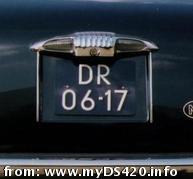
|
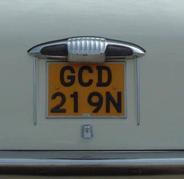
|
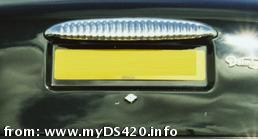
|
The boot lid handle is a landmark: it started in short form, above a square number plate. This model was used until car No. 1M2827, in September 1974, when the internal construction of the boot lock changed. Then for just ten month, the boot lid handle was still short, but had no key lock anymore. An interesting detail is that the short bootlid on cars for France had orange lenses for the reverse lamp. These are also visible on the car once owned by Prince Rainier of Monaco, and now in the car museum at Terrasses de Fontvieille in Monaco. See this photo on Flickr photohosting. After car 1M3082, in July 1975, the long handle was introduced, above a rectangular number plate. From now on, the reverse lamp would become a simple add-on construction hanging under the bumper. Or worse, as shown in this 1984 sales brochure. |
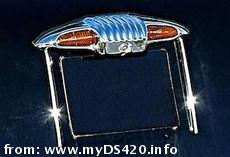
|
|
In February 1974 (car 1M2670) the door locks changed significantly. The leftmost (colour) photo shows the old model. The second photo shows the newer version. The keyholes are positioned higher and closer to the edge now. All this implied a significant change to the internal construction of the locks, to the latching mechanism on the head side of the door, and on the A and B posts. Click on the photos to see an enlarged version, which also shows that the new door is slightly longer than the old one. Also note that the (outer) door handles have a different shape: the round pushbutton disappeared and the shape of the new pushbutton nicely follows the shape of the grip of the handle. The door handles on the inside of the car changed as well; the new version has a rectangular metal plate, fairly large, behind the handle. Note that the top B&W photo shows a very early car, that even has the double chrome sideline, the lower one of which was replaced by a painted coach line in Summer 1971. But that sideline change did not influence the door locks. The lower, widest chrome strip sits very close to the sharp (convex) body edge under the door handles, and the keyholes are much lower than that edge. 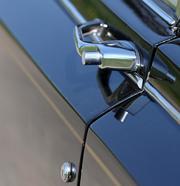
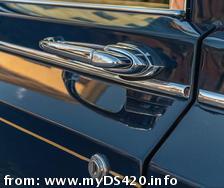
Click on the photos to enlarge. |
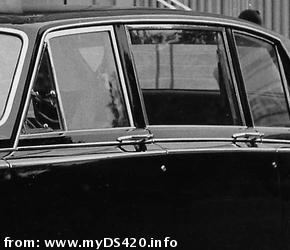
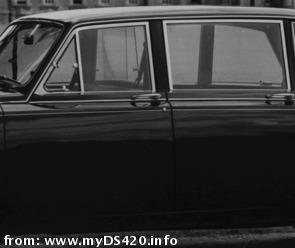
|
|
At the introduction of the DS420, in 1968, it was common practice that exterior mirrors were fitted by the dealer. The very first price lists have them as "Optional Extras" at a price of £sd 5.7.4, tax included. This changed very soon. In March 1969 a letter was distributed to the dealers that two wing mirrors (and seat belts in the front) would from then on be fitted as standard specification. In July 1977 the wing mirrors were replaced by door mirrors. They are much more useful, and for that reason many owners who want to preserve the original wing mirrors mount door mirrors in addition. Daimler fitted mirrors from the manufacturer "Tex Automotive" and, surprisingly enough, Tex still manufactures those mirrors today (2024). See their website: Tex Automotive. The old model (wing mirror) is "Mirror head S1 type flat" with "Mirror stem number 6", and the new model (door mirror) is the "B1 head". Although the later Limousine price lists do not mention a choice of different wing mirrors, very late cars show two different versions, as seen on the rightmost photo. The one without the black bezel seems to be the standard one; it is shown on all press photos, up to the very last one. It is also mounted on the last-of-line car, L420YAC, which is shown at many places on this website. But the one with the black bezel is also present on many very late cars, including the last car for the Queen Mother. |
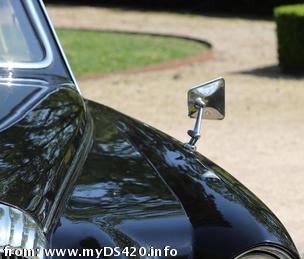
|
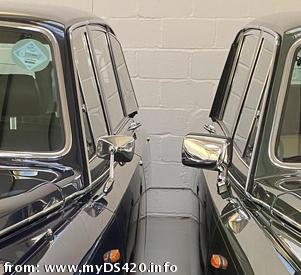
|
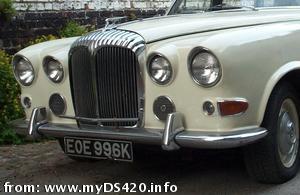
|
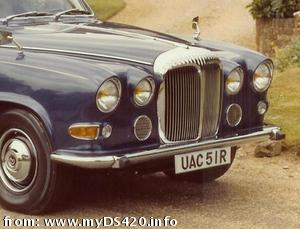
|
The first car to the left shows the bumper with the chrome overriders. This was fitted until November/December 1976 (car No. 1M3381), which is almost 10 years. This particular car has a badge bar, but that was an optional feature. The car at the top right has the rubber block bumper: fitted until 1987 (although its wing mirrors show that this particular car is much older than 1987). Note that the grille sits at the same height as before, and the air inlets are still circular, as on the previous car. The top of both grilles have the extra flap pointing backward, for which a recess was left in the bonnet. This particular car was an export model, and therefore it does not have the flying D because many countries did not allow such a device. From the very beginning, a medallion was fitted instead on cars for A, B, CH, D, DK, F, I, IRL, IS, LUX, NL, S. But the backward pointing flap on the top of the grille is still (barely) visible. Click on the photo to enlarge. The bottom left shows a car after the modification of the air inlets and the side lights, which was done in Summer/Fall 1979 shortly before the production moved from VandenPlas/London to Jaguar/Coventry. This was probably the most outspoken modification that was ever made to the DS420. We still have the rubber block bumpers, and the high grille model, but the grille does not have the backward pointing flap for the Flying D on the top anymore (although this change came slightly later than the change in air inlets). The chrome strip in the centre of the bonnet became much thinner. Finally, bottom right, is a car with the rubber strip bumpers fitted; this happened in 1987. Note how much higher these bumpers sit, with respect to the air inlets! Also note how the direction lights moved into the bumper, and the rectangular side lights therefore changed from orange to white. Because of this difference in height, a totally new grille was fitted: much shorter than the previous one. This difference is even better visible on the photo at the bottom of the page. The oldest model, with the chrome overriders, is by far the most popular one. Quite some owners have "transplanted" this model to their newer car. | |
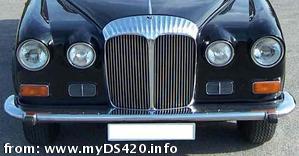
|
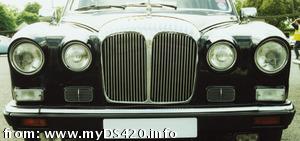
|
|
During the life span of the DS420, three different wheels were used in succession. The oldest were pressed steel wheels, with a chrome rimbellisher (#7 on the parts drawing). Although these rimbellishers are vulnerable and prone to rust, they look really nice. Fortunately, they are still manufactured and stocked e.g. by David Manners (part nr. C.21983) Note how the parts drawing shows a balance weight of the clamp-on type (#3). Applying those is a sure way to have the rimbellisher wriggled off the rim while you are on the road. Ask for the small stick-on weights, that can be attached deeper inside the rim behind the rimbellisher. The wheel on the next photo (yellow car) has one of those clamp-on balance weights, and comparing both photos clearly shows that they are not compatible with a rimbellisher. |
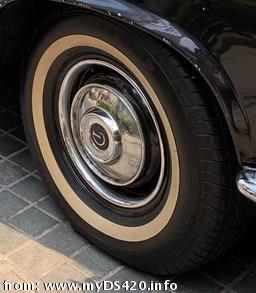
|
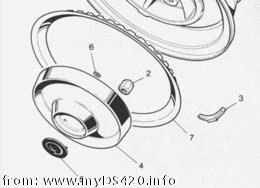
| |
|
In an interview Mr. Keith Cambage, the head of the limousine operations at Browns Lane, made the following comment when discussing the changes made for the 1982 model year: "wheel embellishers were replaced with Silver-Grey wheels. Having to stop on motorways to retrieve a now distorted wheel embellisher and then attempt to fit it caused much grief". In the same interview, Mr. Cambage discussed the third and last change to the wheels, made for the 1989 model year: "Further external enhancement was made with the introduction of Kent Alloy wheels, again being brought about by "on-cost" demanded by the steel wheel suppliers. The alloy wheels already fitted to the Series III models were modified to carry the nave plate of the steel wheels and the effect was quite acceptable to our chief stylist who virtually passed the proposal 'on the nod'". It is not uncommon to see the latest wheels (Kent Alloy) being retrofitted on older cars, by preference of the owner. Tyres: when the DS420 was introduced in 1968 it was fitted with Dunlop H70 HR15 tyres. In more modern terminology that would be 205/70 HR15. But in August 1984 they went to Michelin 235/70 R15, and these are much bigger. How to read these numbers: the first one is the width between the sidewalls, in millimeters; it changed from 205 mm. to 235 mm. The second number is the distance from the rim to the thread surface, expressed as a percentage of the first number. So this went from 70% of 205 mm (= 143.5 mm) to 70% of 235 mm (= 164.5 mm). The last number is the diameter of the rim, in inches (1" = 25.4 mm; 15" is 381 mm). The total height of a wheel thus changed from 381+2×143.5 mm (= 668 mm) to 381+2×164.5 mm (= 710 mm). The difference in height is 42 mm which is slightly over 1.65" and the difference in width is 30 mm which is approx. 1.2" In order to accomodate this extra size the surrounding wheel wells of older cars had to be adapted, which was documented in this Service bulletin. |
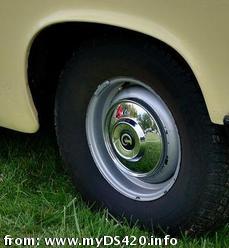
|
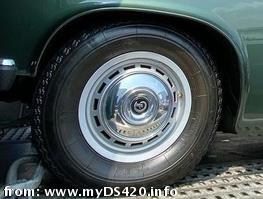
|
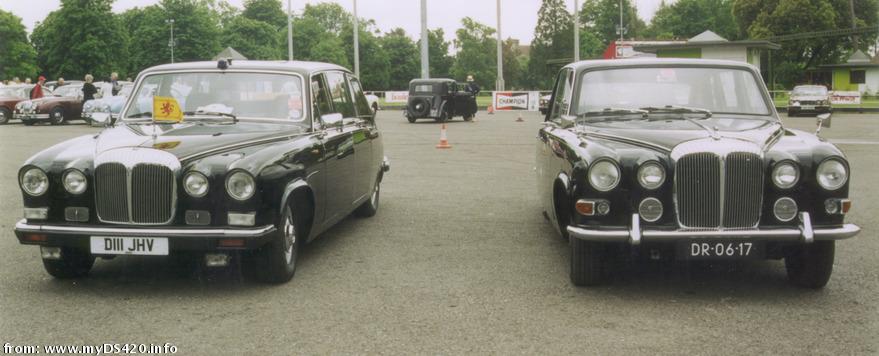
The above picture was taken at the 2003 International Rally of the DLOC in Beaulieu. It shows the 1987 car of club member Ivan Ford (left), and my own 1971 model (right): 16 years and one meter apart. Ivan's car once belonged to Princess Margaret, and still has the "Royal" blue lamp fitted. The actual height of the car did not change. The "nose" of the new car looks much lower, but this effect is caused by the raised bumper and the shorter grill: both "noses" have exactly the same overall height.
To illustrate the different points, I have used my own photographic collection as much as possible. But I also used pictures that I found on other web sites. If you own the rights on one of those pictures, and do not agree with its presence here, please send an e-mail to hjt@xs4all.nl and I will remove that picture immediately.
Back to the
index![]() page.
page.